Project Management: Analyzing PMBOK and PRINCE2 Methodologies
VerifiedAdded on 2023/06/15
|8
|1364
|303
Report
AI Summary
This report provides a detailed comparison of two prominent project management methodologies: PMBOK (Project Management Body of Knowledge) and PRINCE2 (Projects IN Controlled Environments). It outlines the core principles, processes, and themes associated with each methodology, highlighting their similarities and differences. The report discusses how both PMBOK and PRINCE2 address risk management, business case development, and project deliverables. Furthermore, it explores the practical application of PRINCE2 within the project lifecycle, emphasizing its phased approach and adaptability. The document also references various academic sources to support its analysis of these methodologies.
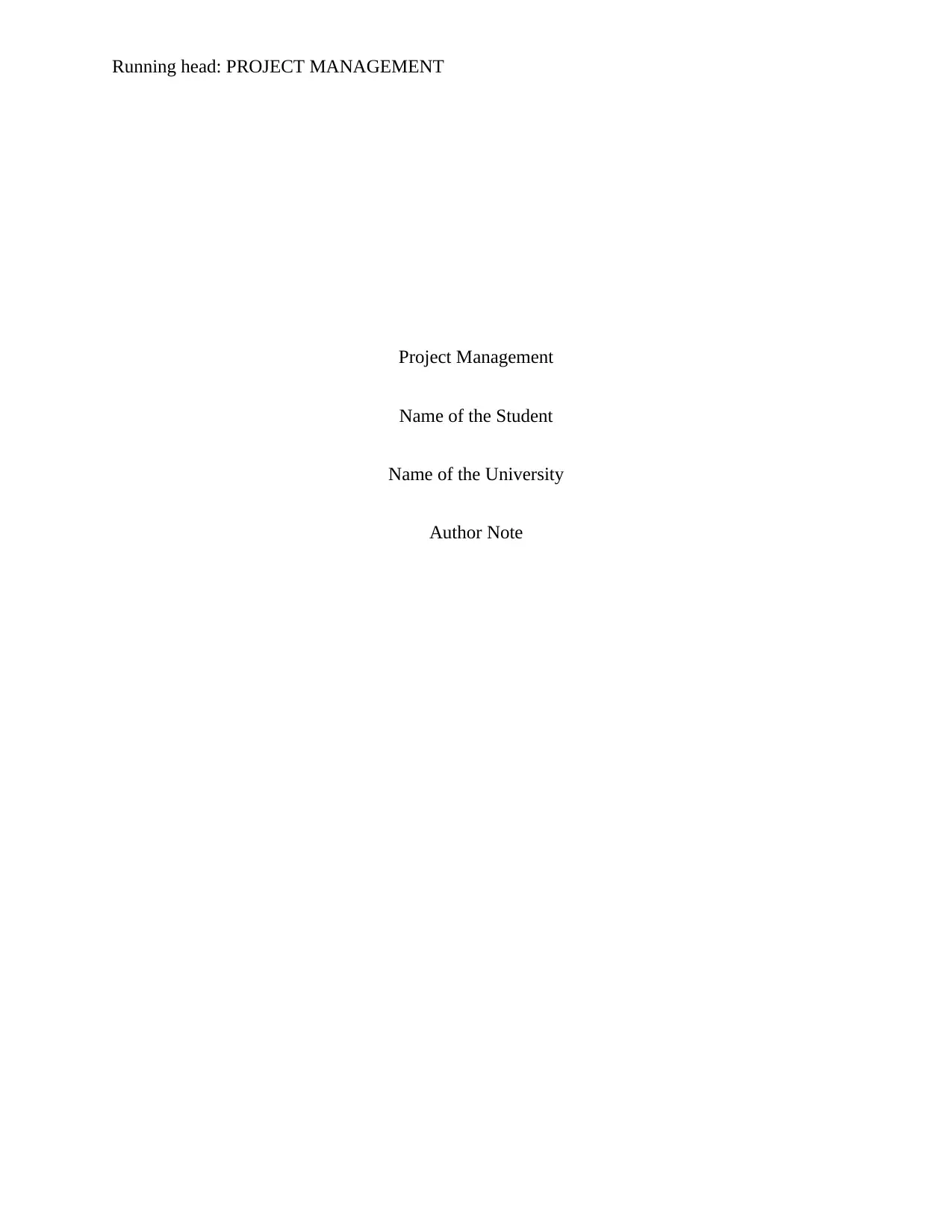
Running head: PROJECT MANAGEMENT
Project Management
Name of the Student
Name of the University
Author Note
Project Management
Name of the Student
Name of the University
Author Note
Paraphrase This Document
Need a fresh take? Get an instant paraphrase of this document with our AI Paraphraser
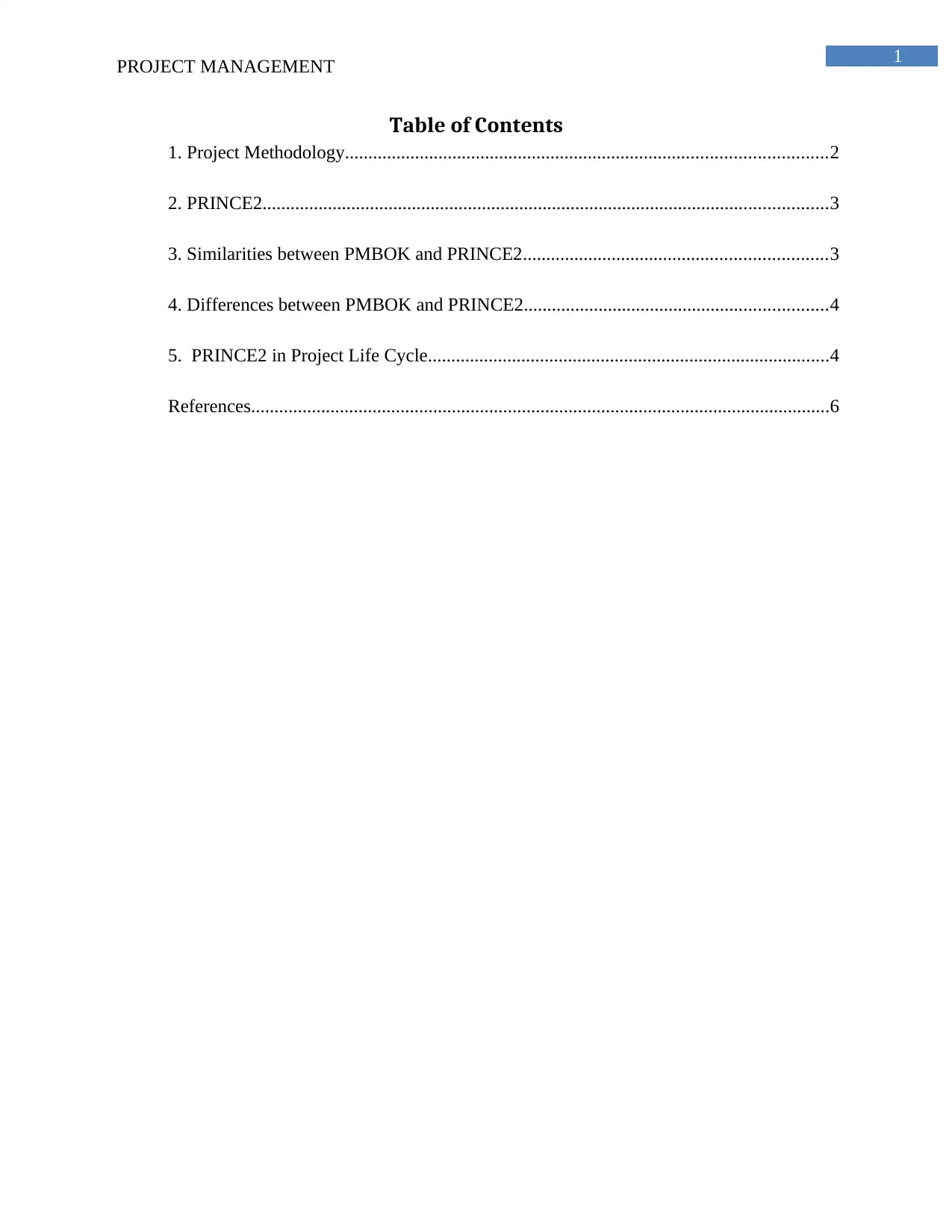
1
PROJECT MANAGEMENT
Table of Contents
1. Project Methodology.......................................................................................................2
2. PRINCE2.........................................................................................................................3
3. Similarities between PMBOK and PRINCE2.................................................................3
4. Differences between PMBOK and PRINCE2.................................................................4
5. PRINCE2 in Project Life Cycle......................................................................................4
References............................................................................................................................6
PROJECT MANAGEMENT
Table of Contents
1. Project Methodology.......................................................................................................2
2. PRINCE2.........................................................................................................................3
3. Similarities between PMBOK and PRINCE2.................................................................3
4. Differences between PMBOK and PRINCE2.................................................................4
5. PRINCE2 in Project Life Cycle......................................................................................4
References............................................................................................................................6
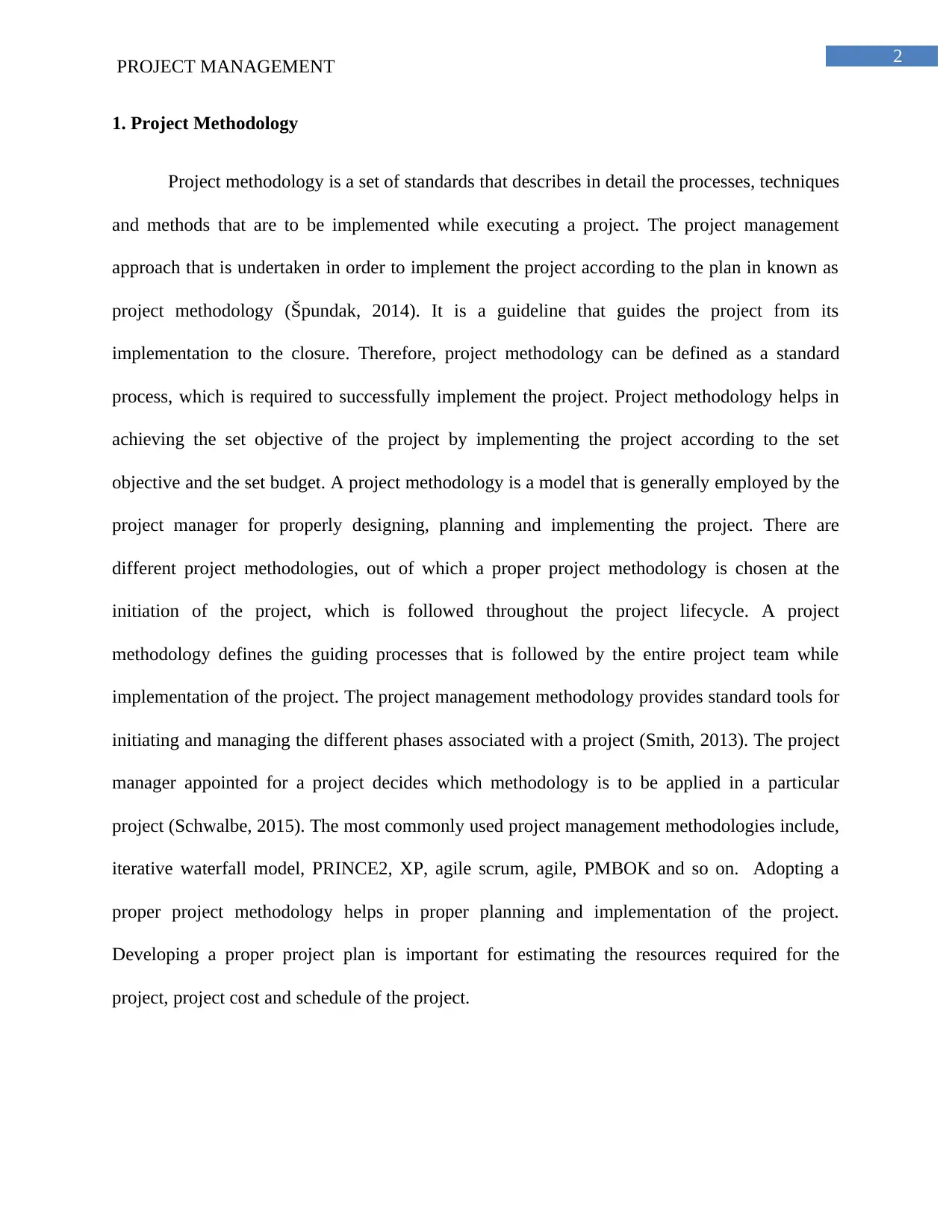
2
PROJECT MANAGEMENT
1. Project Methodology
Project methodology is a set of standards that describes in detail the processes, techniques
and methods that are to be implemented while executing a project. The project management
approach that is undertaken in order to implement the project according to the plan in known as
project methodology (Špundak, 2014). It is a guideline that guides the project from its
implementation to the closure. Therefore, project methodology can be defined as a standard
process, which is required to successfully implement the project. Project methodology helps in
achieving the set objective of the project by implementing the project according to the set
objective and the set budget. A project methodology is a model that is generally employed by the
project manager for properly designing, planning and implementing the project. There are
different project methodologies, out of which a proper project methodology is chosen at the
initiation of the project, which is followed throughout the project lifecycle. A project
methodology defines the guiding processes that is followed by the entire project team while
implementation of the project. The project management methodology provides standard tools for
initiating and managing the different phases associated with a project (Smith, 2013). The project
manager appointed for a project decides which methodology is to be applied in a particular
project (Schwalbe, 2015). The most commonly used project management methodologies include,
iterative waterfall model, PRINCE2, XP, agile scrum, agile, PMBOK and so on. Adopting a
proper project methodology helps in proper planning and implementation of the project.
Developing a proper project plan is important for estimating the resources required for the
project, project cost and schedule of the project.
PROJECT MANAGEMENT
1. Project Methodology
Project methodology is a set of standards that describes in detail the processes, techniques
and methods that are to be implemented while executing a project. The project management
approach that is undertaken in order to implement the project according to the plan in known as
project methodology (Špundak, 2014). It is a guideline that guides the project from its
implementation to the closure. Therefore, project methodology can be defined as a standard
process, which is required to successfully implement the project. Project methodology helps in
achieving the set objective of the project by implementing the project according to the set
objective and the set budget. A project methodology is a model that is generally employed by the
project manager for properly designing, planning and implementing the project. There are
different project methodologies, out of which a proper project methodology is chosen at the
initiation of the project, which is followed throughout the project lifecycle. A project
methodology defines the guiding processes that is followed by the entire project team while
implementation of the project. The project management methodology provides standard tools for
initiating and managing the different phases associated with a project (Smith, 2013). The project
manager appointed for a project decides which methodology is to be applied in a particular
project (Schwalbe, 2015). The most commonly used project management methodologies include,
iterative waterfall model, PRINCE2, XP, agile scrum, agile, PMBOK and so on. Adopting a
proper project methodology helps in proper planning and implementation of the project.
Developing a proper project plan is important for estimating the resources required for the
project, project cost and schedule of the project.
⊘ This is a preview!⊘
Do you want full access?
Subscribe today to unlock all pages.

Trusted by 1+ million students worldwide
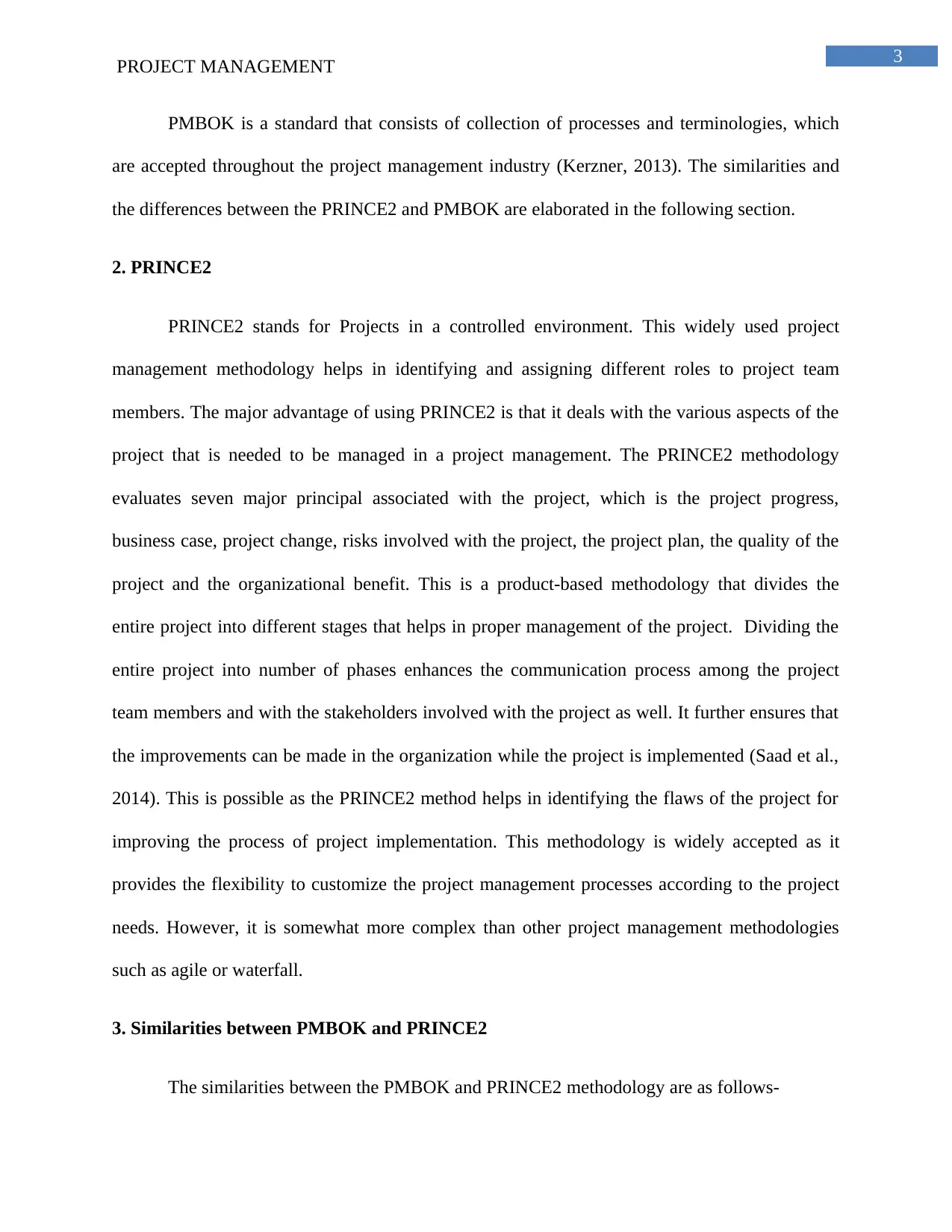
3
PROJECT MANAGEMENT
PMBOK is a standard that consists of collection of processes and terminologies, which
are accepted throughout the project management industry (Kerzner, 2013). The similarities and
the differences between the PRINCE2 and PMBOK are elaborated in the following section.
2. PRINCE2
PRINCE2 stands for Projects in a controlled environment. This widely used project
management methodology helps in identifying and assigning different roles to project team
members. The major advantage of using PRINCE2 is that it deals with the various aspects of the
project that is needed to be managed in a project management. The PRINCE2 methodology
evaluates seven major principal associated with the project, which is the project progress,
business case, project change, risks involved with the project, the project plan, the quality of the
project and the organizational benefit. This is a product-based methodology that divides the
entire project into different stages that helps in proper management of the project. Dividing the
entire project into number of phases enhances the communication process among the project
team members and with the stakeholders involved with the project as well. It further ensures that
the improvements can be made in the organization while the project is implemented (Saad et al.,
2014). This is possible as the PRINCE2 method helps in identifying the flaws of the project for
improving the process of project implementation. This methodology is widely accepted as it
provides the flexibility to customize the project management processes according to the project
needs. However, it is somewhat more complex than other project management methodologies
such as agile or waterfall.
3. Similarities between PMBOK and PRINCE2
The similarities between the PMBOK and PRINCE2 methodology are as follows-
PROJECT MANAGEMENT
PMBOK is a standard that consists of collection of processes and terminologies, which
are accepted throughout the project management industry (Kerzner, 2013). The similarities and
the differences between the PRINCE2 and PMBOK are elaborated in the following section.
2. PRINCE2
PRINCE2 stands for Projects in a controlled environment. This widely used project
management methodology helps in identifying and assigning different roles to project team
members. The major advantage of using PRINCE2 is that it deals with the various aspects of the
project that is needed to be managed in a project management. The PRINCE2 methodology
evaluates seven major principal associated with the project, which is the project progress,
business case, project change, risks involved with the project, the project plan, the quality of the
project and the organizational benefit. This is a product-based methodology that divides the
entire project into different stages that helps in proper management of the project. Dividing the
entire project into number of phases enhances the communication process among the project
team members and with the stakeholders involved with the project as well. It further ensures that
the improvements can be made in the organization while the project is implemented (Saad et al.,
2014). This is possible as the PRINCE2 method helps in identifying the flaws of the project for
improving the process of project implementation. This methodology is widely accepted as it
provides the flexibility to customize the project management processes according to the project
needs. However, it is somewhat more complex than other project management methodologies
such as agile or waterfall.
3. Similarities between PMBOK and PRINCE2
The similarities between the PMBOK and PRINCE2 methodology are as follows-
Paraphrase This Document
Need a fresh take? Get an instant paraphrase of this document with our AI Paraphraser
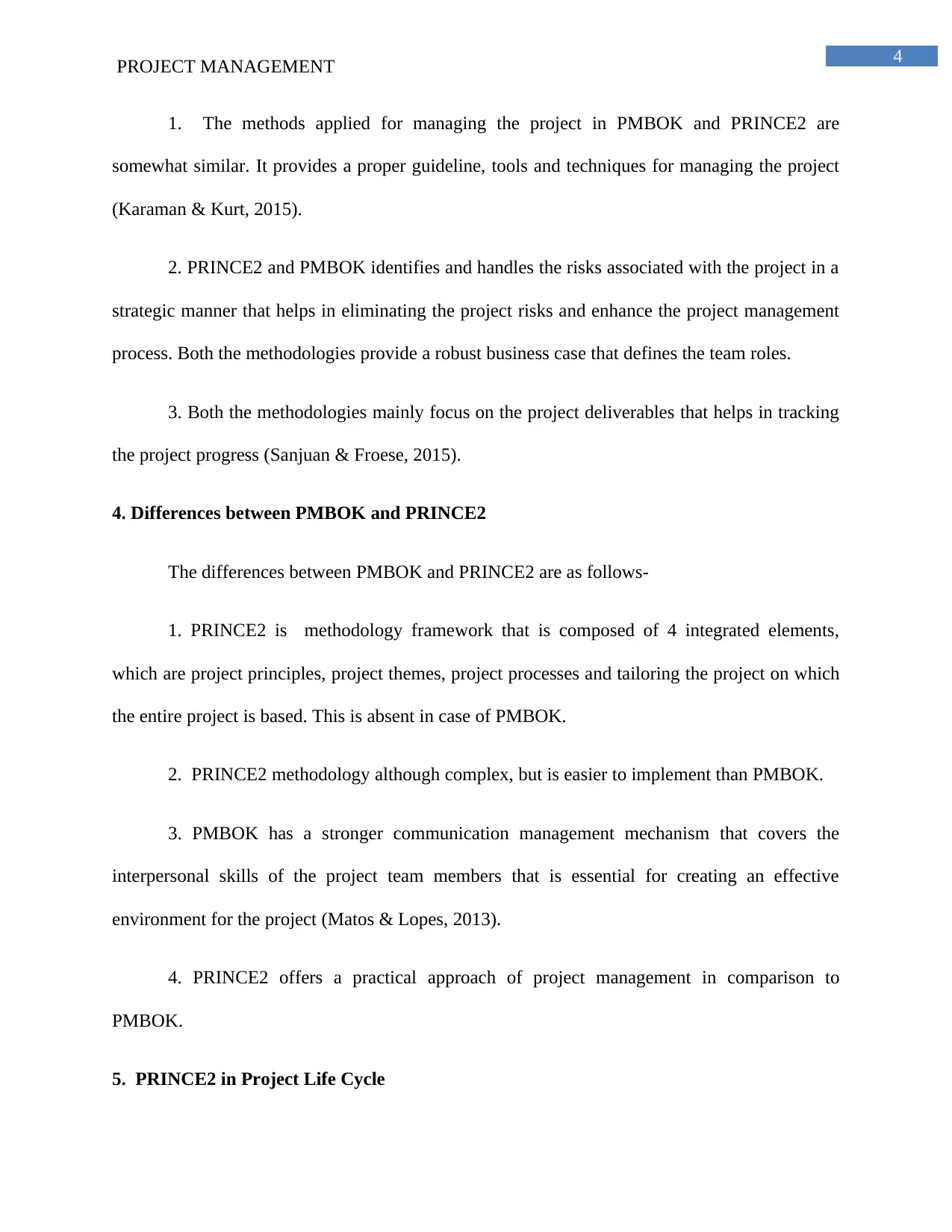
4
PROJECT MANAGEMENT
1. The methods applied for managing the project in PMBOK and PRINCE2 are
somewhat similar. It provides a proper guideline, tools and techniques for managing the project
(Karaman & Kurt, 2015).
2. PRINCE2 and PMBOK identifies and handles the risks associated with the project in a
strategic manner that helps in eliminating the project risks and enhance the project management
process. Both the methodologies provide a robust business case that defines the team roles.
3. Both the methodologies mainly focus on the project deliverables that helps in tracking
the project progress (Sanjuan & Froese, 2015).
4. Differences between PMBOK and PRINCE2
The differences between PMBOK and PRINCE2 are as follows-
1. PRINCE2 is methodology framework that is composed of 4 integrated elements,
which are project principles, project themes, project processes and tailoring the project on which
the entire project is based. This is absent in case of PMBOK.
2. PRINCE2 methodology although complex, but is easier to implement than PMBOK.
3. PMBOK has a stronger communication management mechanism that covers the
interpersonal skills of the project team members that is essential for creating an effective
environment for the project (Matos & Lopes, 2013).
4. PRINCE2 offers a practical approach of project management in comparison to
PMBOK.
5. PRINCE2 in Project Life Cycle
PROJECT MANAGEMENT
1. The methods applied for managing the project in PMBOK and PRINCE2 are
somewhat similar. It provides a proper guideline, tools and techniques for managing the project
(Karaman & Kurt, 2015).
2. PRINCE2 and PMBOK identifies and handles the risks associated with the project in a
strategic manner that helps in eliminating the project risks and enhance the project management
process. Both the methodologies provide a robust business case that defines the team roles.
3. Both the methodologies mainly focus on the project deliverables that helps in tracking
the project progress (Sanjuan & Froese, 2015).
4. Differences between PMBOK and PRINCE2
The differences between PMBOK and PRINCE2 are as follows-
1. PRINCE2 is methodology framework that is composed of 4 integrated elements,
which are project principles, project themes, project processes and tailoring the project on which
the entire project is based. This is absent in case of PMBOK.
2. PRINCE2 methodology although complex, but is easier to implement than PMBOK.
3. PMBOK has a stronger communication management mechanism that covers the
interpersonal skills of the project team members that is essential for creating an effective
environment for the project (Matos & Lopes, 2013).
4. PRINCE2 offers a practical approach of project management in comparison to
PMBOK.
5. PRINCE2 in Project Life Cycle
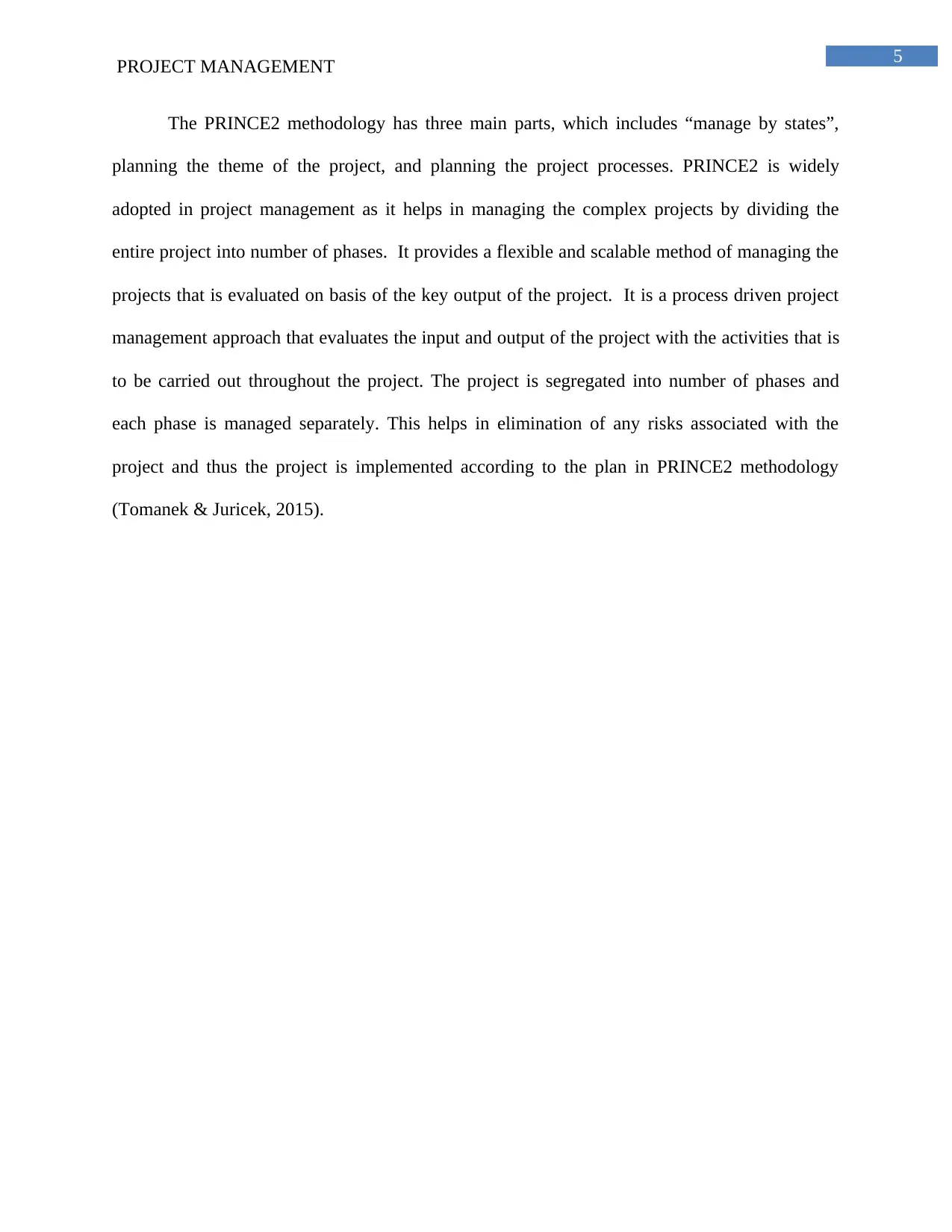
5
PROJECT MANAGEMENT
The PRINCE2 methodology has three main parts, which includes “manage by states”,
planning the theme of the project, and planning the project processes. PRINCE2 is widely
adopted in project management as it helps in managing the complex projects by dividing the
entire project into number of phases. It provides a flexible and scalable method of managing the
projects that is evaluated on basis of the key output of the project. It is a process driven project
management approach that evaluates the input and output of the project with the activities that is
to be carried out throughout the project. The project is segregated into number of phases and
each phase is managed separately. This helps in elimination of any risks associated with the
project and thus the project is implemented according to the plan in PRINCE2 methodology
(Tomanek & Juricek, 2015).
PROJECT MANAGEMENT
The PRINCE2 methodology has three main parts, which includes “manage by states”,
planning the theme of the project, and planning the project processes. PRINCE2 is widely
adopted in project management as it helps in managing the complex projects by dividing the
entire project into number of phases. It provides a flexible and scalable method of managing the
projects that is evaluated on basis of the key output of the project. It is a process driven project
management approach that evaluates the input and output of the project with the activities that is
to be carried out throughout the project. The project is segregated into number of phases and
each phase is managed separately. This helps in elimination of any risks associated with the
project and thus the project is implemented according to the plan in PRINCE2 methodology
(Tomanek & Juricek, 2015).
⊘ This is a preview!⊘
Do you want full access?
Subscribe today to unlock all pages.

Trusted by 1+ million students worldwide
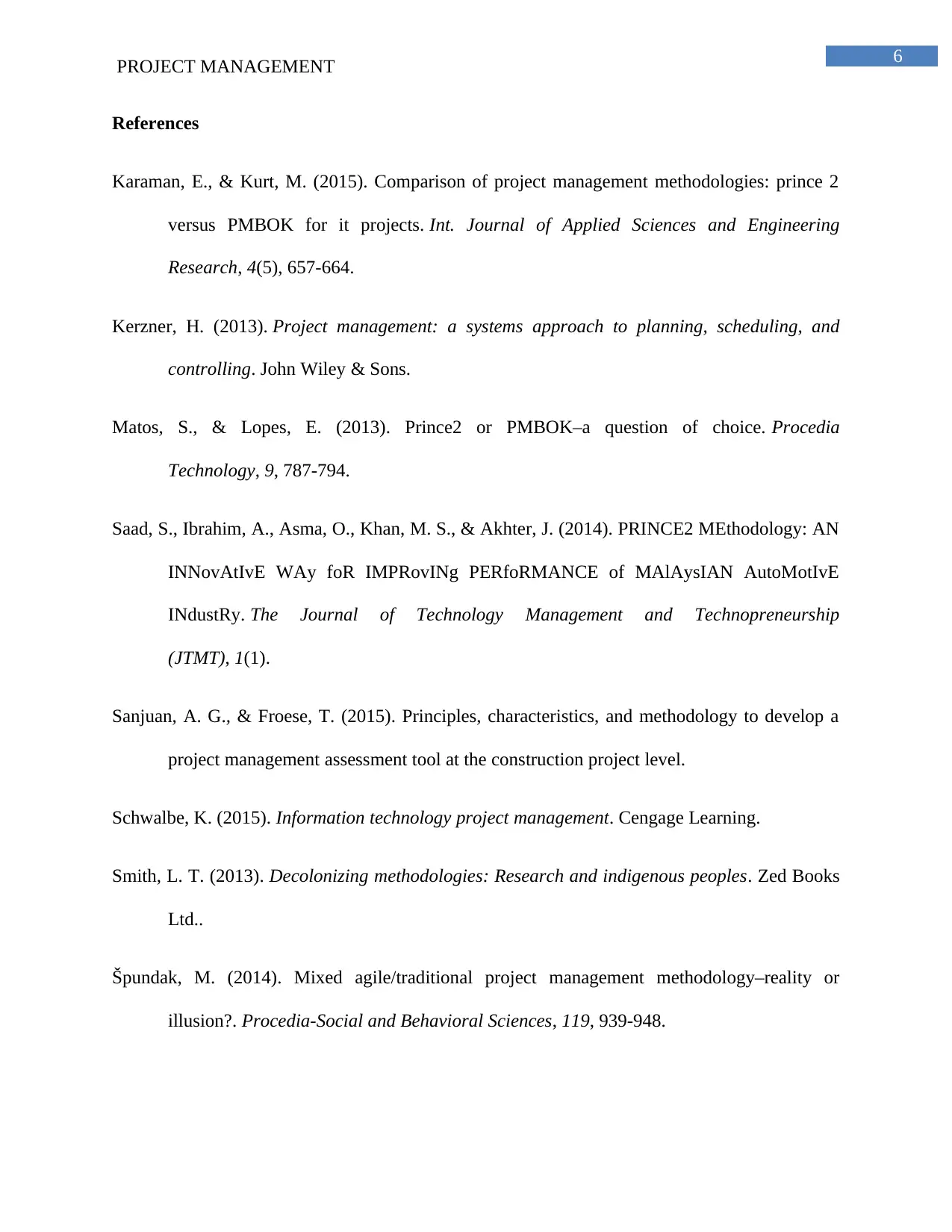
6
PROJECT MANAGEMENT
References
Karaman, E., & Kurt, M. (2015). Comparison of project management methodologies: prince 2
versus PMBOK for it projects. Int. Journal of Applied Sciences and Engineering
Research, 4(5), 657-664.
Kerzner, H. (2013). Project management: a systems approach to planning, scheduling, and
controlling. John Wiley & Sons.
Matos, S., & Lopes, E. (2013). Prince2 or PMBOK–a question of choice. Procedia
Technology, 9, 787-794.
Saad, S., Ibrahim, A., Asma, O., Khan, M. S., & Akhter, J. (2014). PRINCE2 MEthodology: AN
INNovAtIvE WAy foR IMPRovINg PERfoRMANCE of MAlAysIAN AutoMotIvE
INdustRy. The Journal of Technology Management and Technopreneurship
(JTMT), 1(1).
Sanjuan, A. G., & Froese, T. (2015). Principles, characteristics, and methodology to develop a
project management assessment tool at the construction project level.
Schwalbe, K. (2015). Information technology project management. Cengage Learning.
Smith, L. T. (2013). Decolonizing methodologies: Research and indigenous peoples. Zed Books
Ltd..
Špundak, M. (2014). Mixed agile/traditional project management methodology–reality or
illusion?. Procedia-Social and Behavioral Sciences, 119, 939-948.
PROJECT MANAGEMENT
References
Karaman, E., & Kurt, M. (2015). Comparison of project management methodologies: prince 2
versus PMBOK for it projects. Int. Journal of Applied Sciences and Engineering
Research, 4(5), 657-664.
Kerzner, H. (2013). Project management: a systems approach to planning, scheduling, and
controlling. John Wiley & Sons.
Matos, S., & Lopes, E. (2013). Prince2 or PMBOK–a question of choice. Procedia
Technology, 9, 787-794.
Saad, S., Ibrahim, A., Asma, O., Khan, M. S., & Akhter, J. (2014). PRINCE2 MEthodology: AN
INNovAtIvE WAy foR IMPRovINg PERfoRMANCE of MAlAysIAN AutoMotIvE
INdustRy. The Journal of Technology Management and Technopreneurship
(JTMT), 1(1).
Sanjuan, A. G., & Froese, T. (2015). Principles, characteristics, and methodology to develop a
project management assessment tool at the construction project level.
Schwalbe, K. (2015). Information technology project management. Cengage Learning.
Smith, L. T. (2013). Decolonizing methodologies: Research and indigenous peoples. Zed Books
Ltd..
Špundak, M. (2014). Mixed agile/traditional project management methodology–reality or
illusion?. Procedia-Social and Behavioral Sciences, 119, 939-948.
Paraphrase This Document
Need a fresh take? Get an instant paraphrase of this document with our AI Paraphraser

7
PROJECT MANAGEMENT
Tomanek, M., & Juricek, J. (2015). Project risk management model based on PRINCE2 and
SCRUM frameworks. arXiv preprint arXiv:1502.03595.
PROJECT MANAGEMENT
Tomanek, M., & Juricek, J. (2015). Project risk management model based on PRINCE2 and
SCRUM frameworks. arXiv preprint arXiv:1502.03595.
1 out of 8
Related Documents
Your All-in-One AI-Powered Toolkit for Academic Success.
+13062052269
info@desklib.com
Available 24*7 on WhatsApp / Email
![[object Object]](/_next/static/media/star-bottom.7253800d.svg)
Unlock your academic potential
Copyright © 2020–2025 A2Z Services. All Rights Reserved. Developed and managed by ZUCOL.





